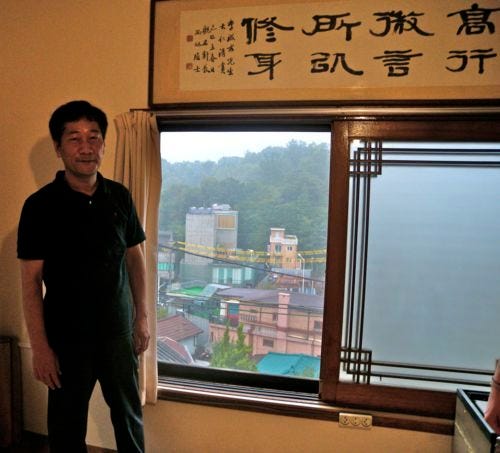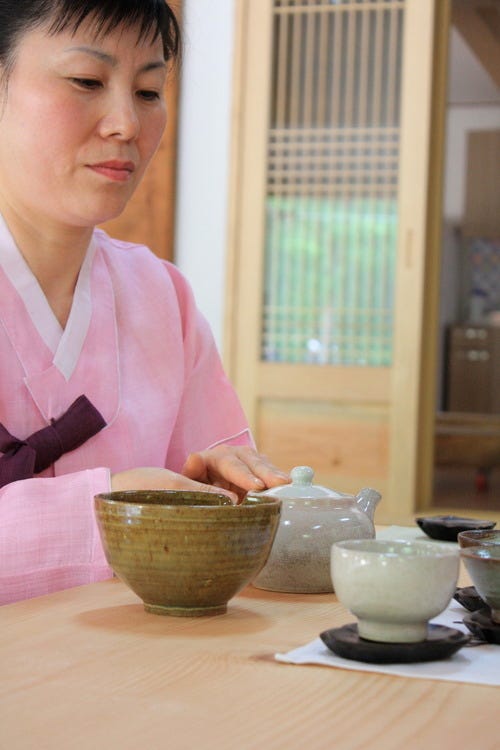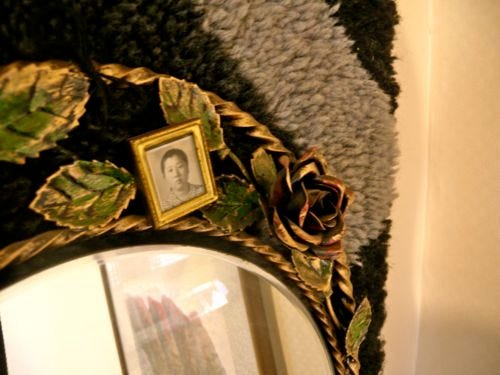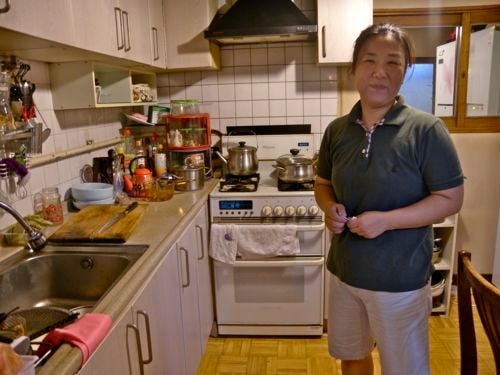The Red Thread that connects us all
How the Korean concept of in yeon changed the way I think about love
“There is a word in Korean, in yeon. It means ‘providence’ or ‘fate.’ But it's specifically about relationships between people. I think it comes from Buddhism and reincarnation. It's an in yeon if two strangers even walk by each other in the street and their clothes accidentally brush. Because it means there must have been something between them in their past lives.” — Past Lives
In light of the recent series I’ve been writing on showing up as ourselves, in solidarity with others around the world — and in honor of Asian & Pacific Islander Heritage Month — I’m re-publishing a revised version of an essay I wrote over ten years ago about in yeon (인연).
In yeon is a uniquely Korean way of thinking about community and love that I learned about from my friends in Seoul, during an unforgettable season of living and teaching there. In yeon is often symbolized by a red thread, tied around the finger, that connects us not only to our one true love, but to everyone else we will meet on the path to our destiny.
As I wrote back then:
“The idea that your destiny dead-ends at the object of your everlasting love is very romantic, of course…. But I liked the emphasis in yeon places on the journey rather than the destination–on the compassion you are supposed to share with everyone, not just your one-and-only.”
In particular, I owe an enormous debt of gratitude to my dear friend and teacher Lee, who helped me to create this piece. I have never forgotten his lessons; they continue to guide my life. (Nor could I forget, because now, thanks to my friends in Korea, I have that red thread tattooed on my right hand.)
May this piece be of benefit to all who are pondering how best to heal the wounds of what Tara Brach calls a sense of “severed belonging,” during this divisive time. May it continue to remind us of the most important lesson of in yeon: we are all in this together.
Love and in yeon (인연)
In the spring 2011, I swung by the coffeeshop after work one night to give the owner, my friend Lee, some strawberries. As usual, I ended up shutting the place down with him. We talked for hours as our coffees cooled, and sampled some “prototypes” of his latest “invention,” a new recipe for a peppermint-flavored latte. (Lee’s a retired chemical engineer, and had been tinkering with the perfect technique for steaming the milk.)
Lee’s wife Yoon brought us a late dinner of topokki, rice noodles with spicy sauce, and twigim, fried vegetable fritters. We all sat around together afterwards, drinking sweet lemon tea. At some point, talk turned to in yeon (인연).
This untranslatable term relates to a uniquely Korean concept of destiny, symbolized by a red thread that connects all of us.
My Korean friends have told me that our in yeon thread is spooled out by the ancestors. That at the time of our birth, one revered grandmother or grandfather spirit comes forward to tie a gossamer strand around our fingers. This weaver of fate winds and loops the thread through time, tying each person to all of the other people they are meant to meet and support in this lifetime, until finally the thread ends at the finger of the person he or she will love forever.
The catch is, to actually find this person, you have to keep your eye on the thread, take each interaction seriously, because that is wonleh geuleonkeoya (원래 그런거야), the way it’s supposed to be. Each meeting is a clue. It’s kismet. It’s maktub. It’s ayni. It’s a bread crumb on your way to your destiny, and it is also the destination.
It is said that “there is in yeon in even the mere brushing of sleeves (옷깃만 스쳐도 인연)”, seuchada (스차다) being the onomatopoeic Korean verb which means “to brush in passing.”
Conversely, if you ignore someone or mistreat someone as you follow your red thread, some believe you will be lost, in a profound metaphysical sense. The thread will fall off your finger, and you will never find your love, or your destiny.

I told Lee that I often felt that this red thread of destiny brought me to Korea, and specifically to Lee’s coffeeshop. I had come to Seoul for so many reasons: to study the food and the language, to try my hand at teaching, to walk in the mountains, and to deepen my Buddhist meditation practice. But the relationships I had come to form with the people I met there had surprised me with their warmth and depth, and I valued them now above all of those other things.
Despite our different cultures and languages, Lee and his wife Yoon had become like a second family to me. While I use their names now in this context, I would more often call them ajashi and imo, respectively — Korean terms for elders that mean “uncle” and “aunt." I also sometimes called Lee “sunsangnim,” which means “teacher,” as he so often took the time to school me about Korean language and culture while wiping down his espresso machine.
On this occasion, Lee was eager to tell me more, but wondered, “How did you come to learn about in yeon, as a waygukin — a foreigner?” Ironically, I told him, through a another waygukin friend’s encounter with a tea shop proprietor.
Tied together with tea and string
My friend Jess, whom I had met in Korea through a mutual friend, first told me of in yeon in the context of a story about getting stranded in the Korean countryside. All the rooms were booked in the small town she and her husband Carlos had chosen to visit for the weekend due to a festival, and they were beginning to panic. Exhausted, they stopped to take a rest in a tea shop. They struck up a conversation with the kind proprietor, who spoke a little English, as many Koreans do. Once she heard the couple’s predicament, Jess told me, the woman invited them both to stay the night in her home, “without hesitation.”
There, Jess and Carlos learned that the kind woman’s daughter was living overseas, where the daughter planned to marry a Canadian man. The woman and her husband hoped that the people in their daughter’s new hometown would show her the same care that they were showing my friends. In a bout of parental pride, they even showed Jess their daughter’s wedding dress, hanging up in the closet – and as they peered more closely at label inside, they realized with delight that it read Jessica.
That love should link these two unlikely parties together, the teashop owner said, was surely in yeon.

In yeon: a brief and incomplete history
After I heard Jess’ lovely story, I told Lee, I’d been very taken with the idea of in yeon, and had begun interviewing all of my Korean friends about it, to better understand what this term meant to them. I’d also begun to research its history online, like I do.
It appears likely that this story was adapted from an older East Asian myth about a red thread of destiny, used by the gods to tie two lovers together. In China, the grandfatherly god Yue Xia Lao is responsible for this cosmic matchmaking; in Japan, the concept of the thread is known as akai ito or unmei no akai ito, and has launched more than a few manga storylines. Apparently, the concept is so well-known in certain areas that “merely holding up the thumb is used as shorthand for girlfriend, and holding a pinky up would indicate a boyfriend.”
The idea that your destiny dead-ends at the object of your everlasting love is very romantic, of course. But I told Lee that I liked the emphasis in yeon places on the journey rather than the destination–on the compassion you are supposed to share with everyone, not just your one-and-only.
Lee agreed with me. He added that as he understood it, an important aspect of Korean in yeon is how it relates to one’s family, and to a belief in past lives. He told me that the people whom you meet and become close with through in yeon, and especially the people in your family, are thought to be people you’ve met many times before.
“I think me, you and Yoon have deep in yeon,” he said. Yoon and I both nodded in agreement.
Lee said husbands and wives are said to have met each other one million times before. “Sometimes meeting with anger, sometimes with love,”
Yoon interjected with a big smile. “Sometimes lots of anger, sometimes lots of love.”

Lee also said that some Koreans believe their children are people to whom they owe a great debt from a past life – which is why Korean parents often seem willing to sacrifice everything for their children. Korean children are not expected to work until they graduate from university (which will, in most cases, be paid for by their parents). They often live at home well into their late 20s, so this is a great commitment indeed. (Later, when his youngest daughter bounded into the coffee shop to ask for a bit of money for dinner with friends, Lee opened the shop’s cash register with a baleful smile and said to me, “See? I owed her a lot from a past life.”)
Family members are connected by deep in yeon and destined to keep meeting. This is because, Lee said, “When you see the suffering of another person and you do not know them, you can choose to look away. But when you see someone in your family suffering, you cannot look away. And regardless, you must keep meeting them. You will always see them again. Even in the afterlife, it is said that I will see my ancestors, my father, and I will bow to them. Your family is your highest in yeon.”
I still love the idea of being tied to all the many special individuals I’ve met in my lifetime, not just one soulmate. In yeon feels like the opposite of the claustrophobic, Cosmo Magazine kind of love peddled in the West, where you exist to please only your partner, and they must meet your every need. It’s the kind of love you feel for the person sitting next to you in the rocking chair or, inexplicably, for the stranger sitting next to you on the plane. It is also the love you feel for the people around the dinner table with whom you’ve fought, it seems, a million times before, and yet you still aren’t walking away.
I think the beauty of the concept of in yeon lies in the way it ties us to our loved ones, past and future, like so many lovely pearls on a string. To keep us from walking away. And when that thread is leading toward your destiny, toward love, toward the repayment of millienia of grace, why would you ever want to walk away?
In yeon, then and now
I would have liked to stay in Korea forever. But my ancestors, it seems, had other ideas for me. My brother was diagnosed with brain cancer that year, and I flew home to serve as one of his primary caregivers. I was devastated to give up my life in Seoul, but resolved to follow my thread, to honor my family as my highest in yeon, as my sunsangnim had taught me. Shortly after I returned home, I got together with the man that would become my husband.
Was it coincidence, or fate, that pulled these threads together? Until I meet my ancestors, I suppose I’ll never know.
I continue to meditate on what in yeon means to me, and where my thread of compassion is leading me now. I am grateful to my Korean friends and colleagues who have generously given their time and emotional labor to my understanding of this topic since I left Korea, in the context of my ongoing research as a writer and historian. Among these are my friends Lee and Yoon above, as well as Young-Joo Lee and Dawn Kang, my friends from Seoul; Lisa Gross, founder of League of Kitchens here in NYC; Kyong-nak Kim, a Korean-American Methodist minister in Queens, NY; and Annie Shin, formerly the ESOL Adult Literacy Program Coordinator at Korean Community Services of Metropolitan New York.
There is a wide diversity of views on this topic within the East Asian diaspora, which, like South Korea itself, is very ideologically diverse. For example, Lee and Young-Joo, as Seoulites, grew up with the concept of in yeon. On the other hand, Lisa Gross, a Korean-American who was raised in the Jewish faith, said her family never spoke of in yeon.
Not all views on in yeon are as romantic as mine, either. Annie Shin’s mother is Buddhist and believes in karmic cycles that span lives, yet Shin prefers the philosophy of Christianity and its notions of starting fresh, with a clean karmic slate. Feeling responsible for the dysfunction of an entire family line can otherwise feel like “too much to bear” for some. Kyong-nak Kim notes that other Koreans who are Christian might feel uncomfortable professing a belief in past lives, or predestination in general. The debate between free will and determinism is also an old one that spans generations and cultures.
More recently, the film “Past Lives,” released in 2023, has now introduced in yeon to many of my film-going friends, which delights me. Greta Lee’s character in the film, Nora, grew up in Seoul, and explains it much like any other Seoulite would:
“There is a word in Korean, in yeon. It means ‘providence’ or ‘fate.’ But it's specifically about relationships between people. I think it comes from Buddhism and reincarnation. It's an in yeon if two strangers even walk by each other in the street and their clothes accidentally brush. Because it means there must have been something between them in their past lives. If two people get married, they say it's because there have been 8,000 layers of in yeon over 8,000 lifetimes.”
At the same time, Nora, who moves to America as a young girl, also puts her own tongue-in-cheek twist on it, when her soon-to-be beau, a Jewish guy from New York, asks her wonderingly, “Do you really believe that?” There’s a long pause, and then she grins, slowly. “That’s just something Koreans say to seduce someone,” she says.
(You can watch the full movie here and the trailer below.)
This wide range of perspectives underscores the difference between describing the cultural and linguistic heritage inherent in a word, and the individual beliefs of the people who share that cultural heritage. To honor AAPI month, for me, is to honor this diversity of views on in yeon within the East Asian diaspora, and all the ways in which these views have enriched my life. I can only hope for a few more lifetimes ahead, in which I can repay this debt.
It’s up to you, dear reader, to decide what you believe about in yeon. But it can’t hurt to treat each person you meet today with kindness, just in case the tale of the red thread turns out to be true… 🧶




Hello Ryan,
This shift—from destiny as possession to destiny as compassion—feels like such a soulful reframe.
In yeon invites us to honor every thread, not just the ones tied in red. Beautifully said.
The concept of "Yeon" warmed my heart in such a profound way. I love that you've shared it here with us, I love and admire all the leaps you've taken in your life, and I love that by chance I stumbled on this today. Thank you so much.